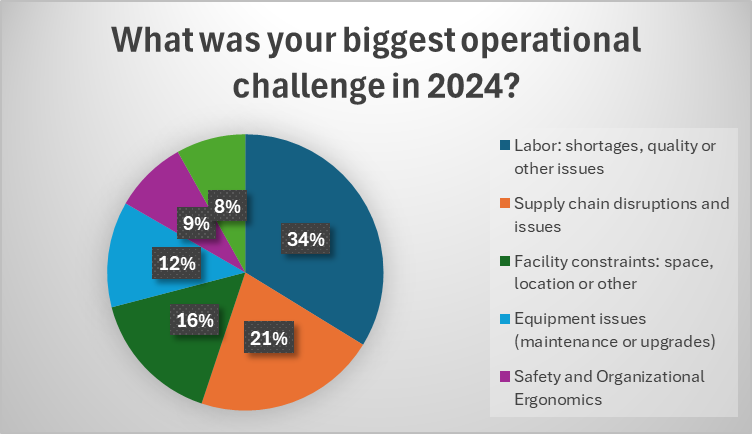Insights: Labor Balance in an Aging Society
Warehousing and manufacturing Insights for June 2025

In 2025, the U.S. labor market is undergoing a significant demographic shift. Approximately 4.18 million Americans reach retirement age this year (about 11,400 turn 65 each day). The Bureau of Labor Statistics projects that the labor force will grow at a modest 0.4% annually from 2023 to 2033, reaching 173.3 million by 2033. The problem: we’ll need to fill 192 million job openings, according to the Bipartisan Policy Center.
FFVA Mutual: Sustainable Workforce in an Aging Society

America’s workforce is aging, and that’s a challenge for manufacturing and warehousing operations. They suffer the double-whammy of aging, skilled workers entering retirement and a much smaller replacement generation that’s far less interested in manufacturing careers. At the same time, America’s industrial sector is on the grow and lacks over 600,000 workers today.
This FFVA article discusses the challenges posed by an aging workforce in warehouse settings and offers strategies to adapt workplaces to meet the needs of older employees, ensuring safety and productivity.
Overall, 22% of American labor is at least 65 years old – Lending Tree Analysis
Key takeaways
- Adjust workplace ergonomics: Ergonomic solutions help accommodate the physical limitations of older workers. You can add years to the productive career of older workers by helping them reduce the stress of physical work. They’ll be more productive, less prone to injury and will stay at the job longer.
- Consider their autonomy: Aging workers are more independent, and are also your most experienced and capable cohort. They will work longer (and better) when they are satisfied in their work. Use their experience by giving them more autonomy in the way they work.
- Train for success: Continuous training keeps aging employees engaged with new technologies and processes. If you’re automating or changing methodology for picking, packing, assembly or storage, they will be the critical group that helps you succeed. Focus training on their needs and mindset to mitigate transitional issues with the changes.
- Focus on their health: Addressing health concerns proactively can reduce injury rates and improve overall workforce well-being. Aging warehouse workers in particular need this focus.
More resources
- 4 Ways Ergonomic Solutions Support Older Workers – MHI
- How Automation & Material Handling Extends the Careers of Skilled Workers – Cisco-Eagle
- Why America Has a Shortage of Skilled Workers – Industry Week
NPR: Why can’t manufacturers fill their jobs?
I’ve covered the looming shortfalls in manufacturing labor extensively in this space because we see this constantly as an issue for our customers. In fact, that’s what customers stressed to us in Cisco-Eagle’s 2025 Warehousing Survey. 33.76% of our respondents said that their top issue was “labor: shortages, quality, or other issues.”

In manufacturing, millions of jobs could go unfilled over the next decade, but that’s too simple. It’s not just about finding people; it’s about finding people with the right skills, especially for roles like equipment technicians. This article breaks down why manufacturers are struggling to hire, how outdated perceptions of factory work play into it, and what programs like FAME are doing to turn things around.
Key takeaways
- Manufacturers could face up to 2.1 million unfilled jobs by 2030, threatening productivity, economic growth, and supply chains.
- The industry must expand its workforce by engaging women, minorities, and veterans, who are underrepresented in manufacturing roles today.
- It’s not just a lack of workers—it’s a lack of workers with the good technical skills, especially for roles like equipment maintenance, robotics, and advanced manufacturing.
- Young Americans don’t like the perception of manufacturing work. They picture manufacturing as dirty or dangerous work, which makes recruiting difficult as aging workers retire.
- Manufacturers are increasing pay and benefits, but still haven’t dented the worker deficit much.
Manufacturers facing unfilled jobs need to act fast
Don’t rely on old hiring methods—invest in modern training and apprenticeships to build the skilled workforce you need. Partner with schools to reach young talent early and show viable career paths. As veteran workers retire, capture their knowledge through mentorship programs. The future of American manufacturing depends on changing how people see—and prepare for—these essential jobs.
Quick hits
- Industry Today discusses the “Transformative Impact of AI in Manufacturing”
- Speaking of AI, (and who isn’t speaking of AI these days), Freightwaves reports that BackOps AI has raised $6 million to “solve warehouse inefficiencies.”
Scott Stone is Cisco-Eagle's Vice President of Marketing with 35 years of experience in material handling, warehousing and industrial operations. His work is published in multiple industry journals an websites on a variety of warehousing topics. He writes about automation, warehousing, safety, manufacturing and other areas of concern for industrial operations and those who operate them.



